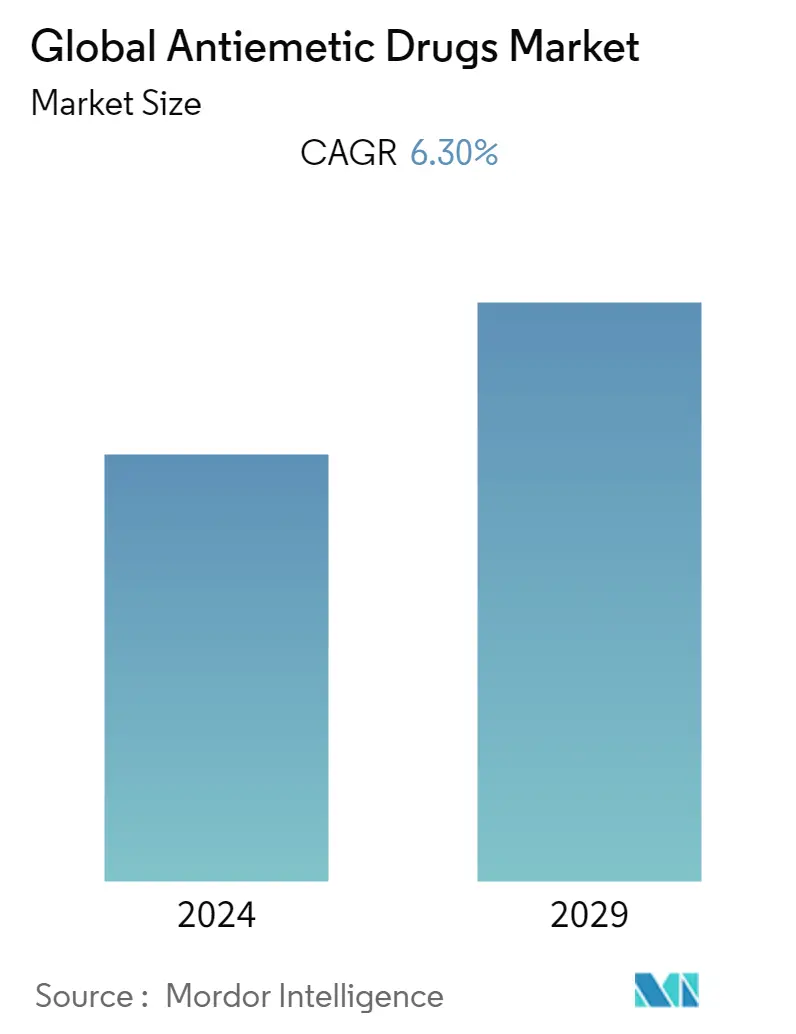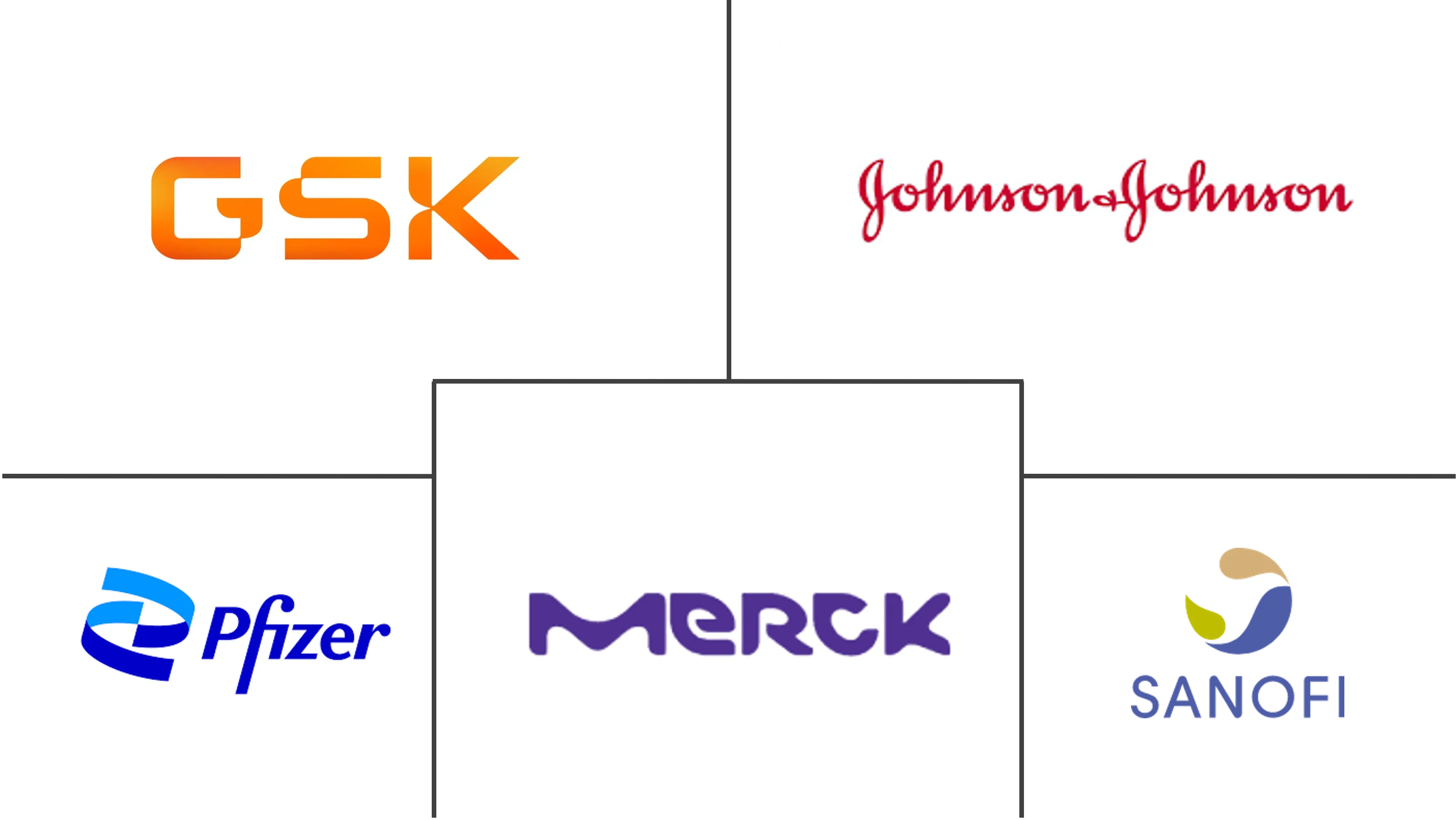Market Size of Global Antiemetic Drugs Industry

| Study Period | 2019 - 2029 |
| Base Year For Estimation | 2023 |
| Forecast Data Period | 2024 - 2029 |
| CAGR | 6.30 % |
| Fastest Growing Market | Asia-Pacific |
| Largest Market | North America |
Major Players
*Disclaimer: Major Players sorted in no particular order |
Antiemetic Drugs Market Analysis
The antiemetic drugs market is expected to register a CAGR of 6.3% over the forecast period, 2022-2027.
The COVID-19 pandemic has had a positive impact on the antiemetic drugs market. The increased cases of SARS-CoV-2 have boosted the use of antiemetics to treat nausea and vomiting induced by COVID-19 or any other medication. For instance, in a study titled "Current Knowledge and recent advances in Intracellular Emetic Signaling System" published in The International Journal of Clinical Practice, 2021, it was observed that the use of antiemetics was severely increased during COVID-19 to treat nausea and vomiting. According to the same source, it was also used in hospitalized COVID-19 patients who might be undergoing open surgery and therefore more prone to nausea and vomiting. Thus, the COVID-19 outbreak positively impacted the antiemetic drug market's growth.
In addition, the increasing prevalence of cancer and gastroenteritis worldwide, the surge in research and development activities, and the identification of new drug targets have been positively affecting the growth of the studied market.
As chemotherapy and gastroenteritis treatments are linked with nausea and vomiting as major adverse effects, antiemetics are an important treatment regimen used in these procedures. According to the data published by the International Agency of Research for Cancer, the global cancer burden is estimated to be 19.3 million new cases, which implies one in five people worldwide develops cancer during their lifetime. For both sexes, the incidence was 2-to-3-fold higher in transitioned nations than in developing nations. As chemotherapy is one of the most widely used treatment protocols for cancer, the adoption of antiemetics is likely to bolster among the patient population as it is accompanied by adverse side effects such as nausea and vomiting. Furthermore, a research study titled "Antiemetic drugs: what to prescribe and when" published in the National Library of Medicine in April 2020 suggested that antiemetics are used in indications like gastroenteritis and chemotherapy-induced nausea and vomiting. These factors are collectively anticipated to drive the demand for antiemetics among cancer and gastroenteritis patients.
Therefore, owing to the aforementioned factors, the studied market is anticipated to witness growth over the analysis period. However, less awareness about antiemetic drugs among the population is likely to impede the market's growth.
Antiemetic Drugs Industry Segmentation
As per the scope of the report, antiemetic drugs are used to treat nausea and vomiting that are side effects of chemotherapy, gastroenteritis, post-operative surgery, or other medications. The antiemetic drugs market is segmented by Drug Type (Serotonin-Receptor Antagonists, Glucocorticoids, Anticholinergics, Dopamine Receptor Antagonists, Neurokinin Receptor Antagonists, and Others), Application (Chemotherapy, Gastroenteritis, Post-Operative Surgery, and Others), and Geography (North America, Europe, Asia-Pacific, Middle East, and Africa, and South America). The report offers the value (in USD million) for the above segments. The market report also covers the estimated market sizes and trends for 17 different countries across major regions, globally.
| Drug Type | |
| Serotonin-Receptor Antagonists | |
| Glucocorticoids | |
| Anticholinergics | |
| Dopamine Receptor Antagonists | |
| Neurokinin Receptor Antagonists | |
| Others (Antihistamines, Cannabinoids) |
| By Application | |
| Chemotherapy | |
| Gatroenteritis | |
| Post Operative Surgery | |
| Others (Vertigo, Motion Sickness) |
| Geography | ||||||||
| ||||||||
| ||||||||
| ||||||||
| ||||||||
|
Global Antiemetic Drugs Market Size Summary
The antiemetic drugs market is poised for significant growth, driven by various factors including the increased prevalence of cancer and gastroenteritis, as well as the surge in research and development activities. The COVID-19 pandemic has positively influenced the market by boosting the use of antiemetics to manage nausea and vomiting associated with the virus and its treatments. Chemotherapy, a common cancer treatment, often leads to nausea and vomiting, necessitating the use of antiemetics, which are also crucial in managing gastroenteritis-related symptoms. The market is characterized by the presence of several key players and a fragmented competitive landscape, with companies like GlaxoSmithKline, Sanofi, and Pfizer playing significant roles. Strategic activities such as product development, approvals, and mergers are expected to further drive market growth.
The serotonin receptor antagonists segment, including drugs like Ondansetron and Granisetron, is anticipated to experience substantial growth due to their effectiveness in preventing nausea and vomiting, particularly post-surgery and during chemotherapy. North America is expected to dominate the market, supported by factors such as high cancer prevalence, economic stability, and increased awareness of healthcare. The region's growth is further bolstered by key drug launches and the presence of major market players. The market's expansion is also supported by regulatory approvals and strategic acquisitions, which enhance product offerings and market reach. Despite the positive outlook, challenges such as limited awareness among the general population may impede growth.
Global Antiemetic Drugs Market Size - Table of Contents
-
1. MARKET DYNAMICS
-
1.1 Market Overview
-
1.2 Market Drivers
-
1.2.1 Increasing Prevalance of Cancer and Gastroenteritis worldwide
-
1.2.2 Surge in Research and Development Activities and Identification of New Drug Targets
-
-
1.3 Market Restraints
-
1.3.1 Less Awareness about Antiemetic Drugs among the Population
-
-
1.4 Porter's Five Force Analysis
-
1.4.1 Threat of New Entrants
-
1.4.2 Bargaining Power of Buyers/Consumers
-
1.4.3 Bargaining Power of Suppliers
-
1.4.4 Threat of Substitute Products
-
1.4.5 Intensity of Competitive Rivalry
-
-
-
2. MARKET SEGMENTATION (Market Size by Value - USD million)
-
2.1 Drug Type
-
2.1.1 Serotonin-Receptor Antagonists
-
2.1.2 Glucocorticoids
-
2.1.3 Anticholinergics
-
2.1.4 Dopamine Receptor Antagonists
-
2.1.5 Neurokinin Receptor Antagonists
-
2.1.6 Others (Antihistamines, Cannabinoids)
-
-
2.2 By Application
-
2.2.1 Chemotherapy
-
2.2.2 Gatroenteritis
-
2.2.3 Post Operative Surgery
-
2.2.4 Others (Vertigo, Motion Sickness)
-
-
2.3 Geography
-
2.3.1 North America
-
2.3.1.1 United States
-
2.3.1.2 Canada
-
2.3.1.3 Mexico
-
-
2.3.2 Europe
-
2.3.2.1 Germany
-
2.3.2.2 United Kingdom
-
2.3.2.3 France
-
2.3.2.4 Italy
-
2.3.2.5 Spain
-
2.3.2.6 Rest of Europe
-
-
2.3.3 Asia-Pacific
-
2.3.3.1 China
-
2.3.3.2 Japan
-
2.3.3.3 India
-
2.3.3.4 Australia
-
2.3.3.5 South Korea
-
2.3.3.6 Rest of Asia-Pacific
-
-
2.3.4 Middle East and Africa
-
2.3.4.1 GCC
-
2.3.4.2 South Africa
-
2.3.4.3 Rest of Middle East and Africa
-
-
2.3.5 South America
-
2.3.5.1 Brazil
-
2.3.5.2 Argentina
-
2.3.5.3 Rest of South America
-
-
-
Global Antiemetic Drugs Market Size FAQs
What is the current Global Antiemetic Drugs Market size?
The Global Antiemetic Drugs Market is projected to register a CAGR of 6.30% during the forecast period (2024-2029)
Who are the key players in Global Antiemetic Drugs Market?
Pfizer Inc, Johnson & Johnson Services Inc, Merck and Co Inc., Cipla Limited and Acacia Pharma Group Plc are the major companies operating in the Global Antiemetic Drugs Market.

